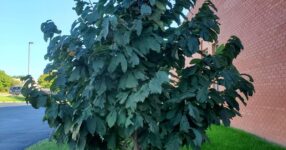Several years ago, we had an extra pawpaw tree (Asimina triloba) after all the plants were distributed at the East Central Illinois Master Naturalist’s Annual Native Tree and Shrub Sale.
Since this poor tree had no home, we decided to plant it outside one of the staff entrances at the Champaign County Extension Office.
I selected a planting site on the north side of our building, assuming it was nearly full shade. However, after I moved far enough away from the building to allow for access space, this move pushed the tree into more sun than I realized.
Nonetheless, the tree has done really well in this location, maturing quickly into an excellent specimen today. It’s safe to say that I have come to adore this tree over the years. Some of the reason is that I walk by it every morning as I enter the building. Or, perhaps it’s because this tree hosts the largest native tree fruit in North America, making it one of my all-time favorite understory tree species.
Beyond my predisposed admiration of the species itself, I have to say that my obsession with this individual tree mostly comes from its interesting and attractive canopy structure. Over time, it has developed a perfectly pyramidal canopy, and when you see the unique, tropical-looking leaves arranged into a compact stack of lustrous green foliage, it’s certainly an ornamental treat.
However, I had not expected to see such a nice and neat canopy structure when we planted this tree. For years, I have observed this plant in extensive patches in the forest understory. I have even planted about a half dozen at my house, creating and inviting fringe to our woodland campfire pit.
In all of these instances, the pawpaws I have in mind are growing in near total shade. They tend to be multi-stemmed and have few side limbs as they mature. Each stem essentially becomes a trunk with a tuft of a canopy at the top, reaching for all the limited sunlight it can afford. The overall limb structure tends to be more spreading than compact.
When I sited our extension pawpaw further out from the building, I unwittingly planted it in more sun than expected.
In fact, after observing the site more over the years, it receives near total sun in the morning hours and only enters full shade around early afternoon. Full sun is typically defined as six or more hours of sunlight per day, and our pawpaw certainly receives a full dose.
It has been so much fun to watch this fantastic little tree develop, but it has also been a humbling reminder on proper landscape placement. While I always assumed the north side of our building was full shade, I failed to recognize that the building was not oriented directly east and west. It has a slight northwest orientation, which creates a nice little pocket of morning sun.
In the end, this location has been a perfect spot for a pawpaw. The shade it receives during the intense afternoon sun is much appreciated, taking the edge off on hot days.
The milder full-sun in the morning is less stressful with the added benefit of influencing canopy structure. In the end, the effects of this planting site were a pleasant surprise, but it always pays to be sure your calculations are correct when adding plants to the landscape.
Are you interested in adding native plants, like this pawpaw, to your landscape? Want help making sure you have the perfect location? Illinois Extension is planning a series of landscape design workshops this winter to help!
Workshop participants will receive assistance from Extension staff, as well as our expert Master Gardeners and Master Naturalists, in these hands-on design workshops.
We’ll help you assess your planting location and design a beautiful and beneficial native landscape on paper that you can implement next year.
We are currently scheduling these workshops for winter 2025 but have not selected exact dates. Based on public interest, we plan to offer multiple sessions. If you’re interested, please join our email list by completing this interest form at go.illinois.edu/nativedesignworkshop.




